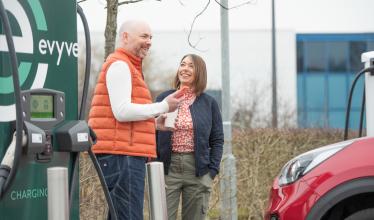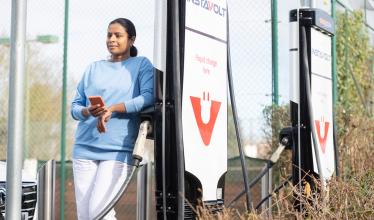Zapmap verdict: ”The entry level Fiat 500 is affordable, has a decent driving range and, even better, is now electric only.”

- ● OTR: £20,995 (City tested)
- ● Category: City car
- ● Tax: £0 VED – 1% BIK
- ● Cost to charge: £3.85
- ● Emissions: 0 g/km CO2
- ● Cost per mile of range: £178
Fiat 500: Range & charging

The latest generation Fiat 500 is built on a tailored EV architecture, with two battery/motor options. The model tested uses the shorter-range 24 kWh battery pack, and can be rapid charged at up to 50 kW DC.
There is one configuration available with the 24 kWh battery:
-
- ● Fiat 500 City – 70 kW – 24 kWh – 118 miles
Range
The official WLTP driving range for the Fiat 500 24 kWh is 118 miles on a charge. Real-world driving quickly shows how efficient the Fiat is, with that official range comfortably achievable, and only dropping to around 100 miles on a charge when sitting at 70mph. Otherwise, most drivers will regularly reach 130-140 miles per charge.
Braking
There are three driving modes available – Normal, Range, and Sherpa. The latter two feature ‘one-pedal’ driving, allowing strong brake energy recuperation, even to a full stop, for efficient driving. Normal allows for light regen, improving the coasting ability of the 500 at higher speeds. The set-up works well, and is easy to use.
Charging
Charging is available at up to 11 kW AC on any configuration of new Fiat 500. This more compact battery model can rapid charge at up to 50 kW DC, which keeps the recharging time for 0-80% to around 30 minutes. Charging on an 11 kW point will take around 2h 30m or 3h 30m on a 7 kW unit.
The Fiat 500 City on the road

This 24 kWh model uses a 70 kW electric motor, compared to the larger battery’s 87 kW motor. It brings a 0-62mph time of 9.5 seconds, with shorter sprints completed eagerly. It’s ideally suited to town work, but will cope with faster speeds without issue.
What’s the Fiat 500 like to drive?
Slightly lighter than the Long Range model, the 500 City handles with aplomb. It’s balanced between comfort and agility, and sits up there with the best in class. Some rivals offer a more dynamic drive, whilst others are more comfortable, but the 500 manages to blend both aspects nicely and it’s a first class city car.
Fiat 500: Comfort & Practicality

The Fiat 500 has plenty of space … as long as you’re sitting in the front seats. Anyone larger than a child is likely to feel squashed into the rear, and the boot space is compact too. However, this is likely to be known about by a great many Fiat 500 buyers before they take a look, so it won’t come as a surprise, and few will be put off. It’s possible to fit four and some luggage into the 500, but it’s more likely to be used as (and better suits) being a two-seater with added practicality.
Design and functionality
The 500 City is the entry level model in the range, and as such is more basic than most 500s that will hit the road. Still, it’s got a fair amount of kit, and there are lovely touches to its past and birthplace dotted about. Materials used are nice throughout for the price, and driving controls fall easily to hand. It’s simple – with no infotainment system, rather a connected phone app – but covers everything a buyer might need.
Fiat 500: Tech & Specifications

There are three core trims to the 500 range, but just the Action available with a 24 kWh battery. Fitted as standard are:
- 15-inch steel wheels
- Smartphone cradle
- Digital driver’s instruments
- Keyless start
- Air conditioning
- Rear parking sensors
- One-pedal driving
- Lane keep assist
The electric city car market is a busy one, but the Fiat 500 stands out with great design. Look beyond the styling however, and there is plenty of substance behind the scenes. It’s a fantastic city car, well suited to electric driving and efficient at that. It’s fun, comfortable, has a reasonable range, and only really lacks rear practicality to stop it dominating the market. A brilliant reinvention of the famous 500, even at entry level trim.
And how much is the road tax on a Fiat 500? Use our Car Tax Calculator to find out.
All information above correct at time of publication. Official economy figures, pricing, and tax rates supplied by the manufacturer. Cost to charge based on 0-100% charge at home on a tariff of 16 p/kWh.



